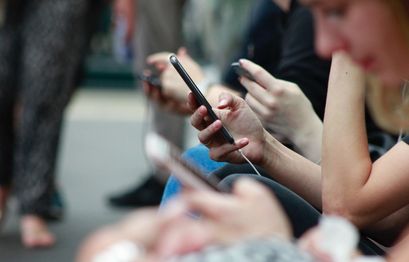
Even if you are among the lucky ones able to resist the hypnotic glow of mobile devices, you probably know many people who can’t put their phones down. Classified as an impulse disorder, such behavior is not unusual, with more and more people suffering from phone addiction.
So, let’s check the most recent phone addiction statistics to see how phone-related behaviors can become quickly compulsive and distracting.
Top Ten Phone Addiction Statistics
In 2021, the United States had nearly 274 million smartphone users.
In 2021, consumers spent $170 billion on mobile apps.
The average person spends 4.8 hours daily using a phone.
There are over 5.22 billion mobile phone users worldwide.
53% of American adults say they have never gone longer than 24 hours without their phones.
42% of Americans check their phones at the dinner table.
39% of people aged 18 to 30 report phone addiction symptoms.
31% of the gen Z population feels uncomfortable without their phones.
25% of people admit that cell phones cause arguments in their relationships.
94% of teenagers access the Internet via a smartphone daily.
The Latest Statistics About Cell Phones
In 2021, the United States had nearly 274 million smartphone users.
The number of cell phone users in the US nearly tripled between 2011 and 2021, and the projections for 2023 say that the total number could exceed 300 million.
Nevertheless, China still has three times more smartphone users than the US, with over 950 million cell phone owners. India is also ahead of the United States, given that it had around 493 million users in 2021.
(Statista)
In Q1 2022, Samsung held 21% of the global smartphone market share.
The latest stats about cell phones reveal that Samsung leads the chase among the vendors in the global smartphone market. Apple and iPhone held the second spot with an 18% market share in the first quarter of 2022.
After the 2021 trade restrictions, Huawei has not featured among the top five vendors. However, Xiaomi held its position as the third best-selling smartphone brand, with a 12% market share in Q1 2022.
(Statista)
In 2021, consumers spent $170 billion on mobile apps.
Most smartphone users' obsession with phones starts with interactive and engaging mobile apps. After all, cell phone users have spent 3.8 trillion hours on mobile apps in 2021, an all-time high.
Similarly, global spending on mobile apps increased by 20% compared to 2020, with nearly $116 billion going toward mobile gaming and several other high-performing apps.
(Forbes)
The average person spends 4.8 hours daily using a phone.
Smartphone users often catch themselves endlessly scrolling, and recent data shows that we spend nearly five hours daily on our phones. Moreover, smartphone addiction statistics show that the average daily usage increased by 30% compared to 2019.
In other words, cell phone users spend one-third of their waking hours looking at their smartphones. Interestingly, Americans are below the global average, with 4.1 hours of daily cell phone usage.
(Forbes)
More than 80% of the population in high-income countries owns a smartphone.
Smartphone ownership worldwide is still rising, with adolescents and young adults driving the increased smartphone adoption. Globally, around half of the population owns a smartphone.
As expected, smartphone ownership is more pronounced in high-income countries, and smartphone addiction follows the same patterns. In other words, the more phones, the higher the likelihood of compulsive phone-related behaviors.
(Science Direct)
The smartphone penetration rate is 90% or higher in high-income US households.
In the previous decade, smartphone ownership in the US more than doubled. Namely, only 35% of all Americans owned a smartphone in 2011, compared to 85% who owned these devices in 2011.
In addition, more than 90% of US households with an annual income of fifty thousand dollars or more had smartphones in 2021. On the other hand, households earning below the same threshold had an 80% smartphone penetration rate.
(Statista)
Cell Phone Usage Statistics
There are over 5.22 billion mobile phone users worldwide.
Although it’s almost impossible to determine the precise number of smartphone users because the figure constantly changes, recent data reveals that 66.6% of the world’s population owns a mobile phone today.
Since January 2020, the global smartphone owner base has grown by 1.8%, while individual mobile connections have increased by 0.9%.
(Data Portal)
53% of American adults say they have never gone longer than 24 hours without their phones.
According to smartphone addiction statistics for 2022, 71% of American users check their phones within ten minutes of waking up. The worrisome trend continues as we browse the findings of a recent study, given that 74% of US adults feel uneasy if they leave their phones at home.
Likewise, 35% of American phone owners admit to looking at their mobile phones while driving. Similarly, 64% say they use their smartphones on the toilet, while 43% check their phones while on a date.
(Reviews.org)
Americans, on average, spend 2 hours and 54 minutes daily on their phones.
Cell phone usage is growing worldwide, and the United States is no exception. After all, the average American spends nearly three hours daily using their smartphone.
So, over a calendar year, the average phone owner in the US spends approximately a month and a half (44 days) scrolling, texting, or calling.
(Reviews.org)
42% of Americans check their phones at the dinner table.
Smartphones have infiltrated every area of human activity, and many phone owners can’t have dinner with friends or family without checking for notifications. Nevertheless, only 18% of American homes have a so-called “no phone zone.”
At the same time, more than half (56%) of responders in a recent cell phone usage survey said they agree (22%) or strongly agree (34%) that reducing their phone time would make their partners happier.
(Sell Cell)
76% of smartphone owners use mobile devices to chat and send messages.
A comprehensive worldwide study conducted between July 2021 and June 2022 revealed that more than two-thirds of smartphone owners use phones to communicate with others.
The second-most-popular activity was sending emails, while 61% of respondents said they use smartphones to consume video content.
(Statista)
Cell Phone Addiction Statistics
39% of people aged 18 to 30 report phone addiction symptoms.
More than a third of adolescents and young adults experience symptoms of smartphone addiction, including anxiety and distress when unable to access their mobile devices. In addition, they lose control of how much time they spend on their phones.
Approximately 25% of those people use their phones for more than three hours daily, and an additional 18.5% admit to using their smartphones for over five hours.
(Scotsman)
31% of the gen Z population feels uncomfortable without their phones.
Young people’s dependency on smartphones is problematic, and the latest smartphone addiction statistics show that more than half (55%) of gen Z members use their phones for 5+ hours a day.
A third of them feel uneasy without a phone for 30 minutes or less, and many experience symptoms of codependency when spending extended periods without their cell phones.
(The Conversation)
71% of smartphone owners spend more time with their phones than their romantic partners.
Cell phones affect almost every aspect of human lives, including romantic relationships, marriages, and friendships. So, it’s not surprising that more than two-thirds of people spend more time scrolling than interacting with their loved ones.
Interestingly, phone usage statistics show that women are the worst phone snubbers, with 78% preferring to spend time on the phone than with their partner. In addition, 80% of women check their phones before greeting their partners in the morning.
(Sell Cell)
25% of people admit that cell phones cause arguments in their relationships.
Smartphone overuse affects a quarter of relationships in the US, and the increased adoption of mobile devices will probably worsen things. After all, most smartphone addiction articles paint a pessimistic picture of the future since 30% of people prefer to message their partner than have a face-to-face conversation.
For instance, statistics say that 72% of men would prevent their partners from using cell phones if they could, while 43% say they have caught their partners snooping on their cell phones. On top of that, 17% of women admit to interrupting bedroom intimacy to check their phones.
(Sell Cell)
Cellphone usage accounts for 70% of the time spent consuming digital media.
We often refer to smartphones as mini-computers because the modern cell phone is much more than a communications device. Moreover, many people rarely use smartphones for calling or texting since these convenient gadgets allow us to consume content anytime, anywhere.
For instance, 94% of people consume gaming content through smartphones. The situation in the social media (92%) and general entertainment categories (83%) is similar.
(Marketing Charts)
Teenage Cell Phone Addiction Statistics
27% of smartphone owners aged 11 to 14 never turn their cell phones off.
Various studies confirmed that teenagers are the most likely to suffer from addiction to cell phones. After all, young adolescents going through puberty are the most at risk of experiencing behavioral problems, including compulsive phone-related behaviors.
For example, recent studies revealed that nearly a third of young teens never turn off their smartphones, even to sleep.
(Verizon)
A quarter of teenagers in South and East Asia have a smartphone addiction.
Mobile addiction plagues almost all modern countries and societies, and a recent comprehensive survey revealed that 25% of teenagers and young adults from East and South Asia experience smartphone addiction symptoms.
While experts agree that smartphone addiction is often higher in the Asian population than in Western samples, overall phone usage and smartphone penetration leave little room for significant discrepancies in results.
(Frontiers)
In 2019, 84% of US teens owned a smartphone.
The statistics on cell phone use from 2015 show that 67% of American teenagers owned a smartphone. Consequently, only 53% of teens in 2015 confirmed they texted on any given day.
As expected, the finding changed by 2019, when 84% of teenagers had a smartphone, with 78% texting their friends and loved ones on any given day.
(Common Sense Media)
94% of teenagers access the Internet via a smartphone daily.
The Internet revolutionized our lifestyles, and the widespread adoption of smartphones allows more people than ever to access the World Wide Web. For instance, statistics related to smartphone addictions say that nine out of ten access the Internet at least once daily.
Even though only 24% of smartphone-owning teenagers consider themselves online “almost constantly”, 92% admit to accessing the Internet daily.
(PsychGuides)
28.4% of teenage girls use social media for 5+ hours per day.
Teenage girls are more likely to use smartphones and social media apps heavily. For instance, 28.4% of girls spend five or more hours on social media daily, compared to 13.7% of males of the same age.
In addition, 43.8% of teenage boys use social media for less than an hour per day, compared to 22.8% of females.
(NPR)
Conclusion
Most humans are reliant on cell phones, and these devices have evolved into our constant companions. Yet, as you could’ve seen from the latest phone addiction statistics, smartphones offer many benefits but also come with a few drawbacks.
Thus, understanding the risks of overuse is essential, with prevention being the first stage of defense against compulsive phone-related behaviors. In other words, we should inform and educate cell phone users before everyday use spirals into addiction.
FAQ
How many people are addicted to their phones?
How many hours on the phone is addiction?
Who is most addicted to phones?
What are the effects of smartphone addiction on students?
Which country has the most mobile addiction?
Why phones are so addictive?
Sources:






